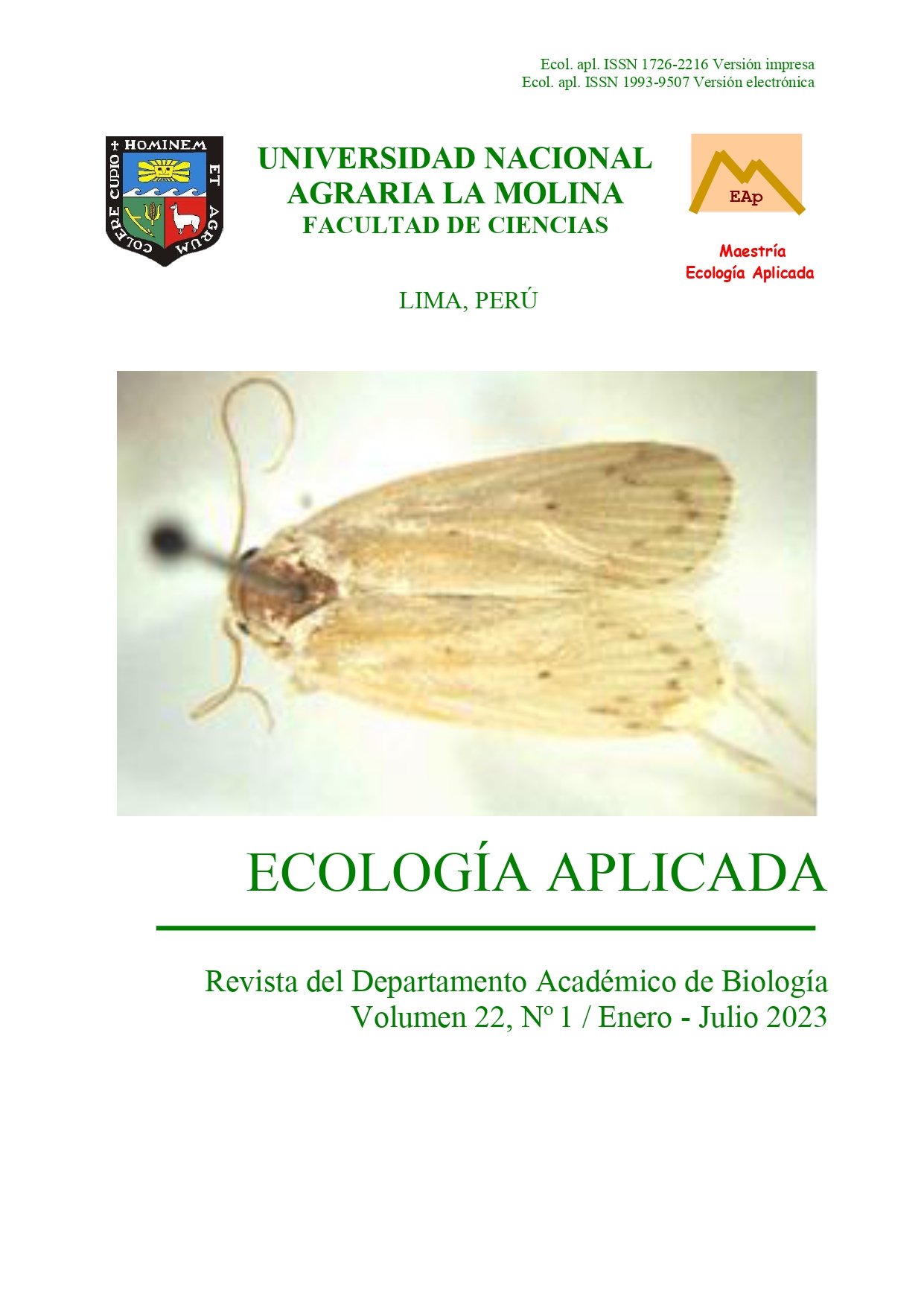THE NATURAL CONTROL OF Stenoma catenifer WALSIMGHAM IN THE CULTIVATION OF AVOCADO CROP Persea americana MILL. IN CHANCHAMAYO, PERU
DOI:
https://doi.org/10.21704/rea.v22i1.860Keywords:
Stenoma catenifer, biological control, parasitoids, Apanteles spp., Persea americana, avocadoAbstract
Avocado cultivation (Persea americana Mill.) was very important in Chanchamayo and Satipo until 1982, when the area contributed 47% of the national production, and was affected by "root rot" caused by the fungus Phytophthora cinnamomi Rands. Based on the evaluations carried out between 1983 and 1987 by the authors, this work has been prepared updating the information to the present in the area. The objective is to demonstrate that the "avocado fruit borer" Stenoma catenifer Walsimgham remained as a potential pest due to the existence of a natural control by native parasitoids. The method was to record the abundance, importance, damage, alternate hosts, and associated natural enemies; based on periodic monthly collections of insects in avocado plantations and in the herbaceous vegetation of cultivation and rearing in the laboratory, recording the pest species and natural control insects. It is concluded that this pest S. catenifer presented different degrees of preference for fruits according to the cultivars evaluated and two species of parasitoids that alternated their abundances during the campaign. These parasitoids maintained a biological control of ± 70% on the avocado fruits, and the farmers were not economically affected; thus, it could be considered to leave this pest species in the category of potential.
Downloads
References
AGROLINE. 2023. Tailandia, nuevo destino de exportación para la palta Hass. Noticias. AGROLINE, julio 8, 2019. Consultado el enero 11 de 2023 de: https://www.agronline.pe/noticias/tailandia-nuevo destino-de-exportacion-para-la-palta-hass/.
Arellano G. & Vergara C. 2016. Especies de Miridae (Hemiptera) registradas en algunos cultivos tropicales en Chanchamayo y Satipo. Junín – Perú. Ecología aplicada, 15(2): 101-106. DOI: http://dx.doi.org/10.21704/rea.v15i2.749.
Arellano G., Vergara C. & Bello S. 2015. Plagas entomológicas y otros artrópodos en el cultivo de la piña (Ananas comosus var. comosus (L.) Merr., Coppens & Leal) en Chanchamayo y Satipo, departamento de Junín, Perú. Ecología Aplicada, 14(1-2): 175-189. DOI: http://dx.doi.org/10.21704/rea.v14i1-2.94.
Arellano G.A. 1998. El "barrenador del fruto del palto" Stenoma catenifer Walsh. y su control natural en Chanchamayo y Satipo. Ecología, 1(1): 55-58. Revista de la Asociación Peruana de Ecología. Versión impresa.
Arellano G.A. 2001. Evaluación de plagas en Café, Papayo, Piña, Palto, Plátano y Cítricos en Chanchamayo y Satipo. Tesis para optar el grado de Magister Scientiae, Especialidad Entomología de la Escuela de Post Grado, Universidad Nacional Agraria la Molina, , Lima – Perú. https://repositorio.lamolina.edu.pe/bitstream/handle/20.5 00.12996/1646/H10-A74- T.pdf?sequence=7&isAllowed=y.
Bello S. 1989. El cultivo de la piña (Ananas comosus L. Merr) en la Selva Central del Perú) y algunos estudios realizados para mejorar la tecnología. Trabajo Profesional para optar el Título de Ingeniero Agrónomo. Universidad Nacional Agraria La Molina.
FAO. 1983. WORLD BANK COOPERATIVE PROGRAMME. Report of de Chanchamayo – Satipo Rural Development Project. Report N0 28 -83.
Faura C. 1967. Breve Reseña del estudio y prácticas entomológicas realizadas en Chanchamayo y sus principales cultivos. Ponencia presentada en la XII Convención Nacional de Entomología Tarma. Mimeografiada por la Sociedad Entomológica del Perú.
Heppner J.B.1994. Atlas of Neotropical Lepidoptera - Checklist: Part 2 Hyblaeoidea – Pyraloidea - Tortricoidea. Editorial: Scientific Publishers, Gainesville.
Lozada P.W. & Arellano G.A. 2008. Lista preliminar comentada de las "cigarritas" (Insecta: Hemiptera: Cicadellidae) de Chanchamayo y Satipo, Perú. Ecología Aplicada, 7(1-2): 117-122. DOI: http://dx.doi.org/10.21704/rea.v7i1-2.366
MINAGRI. 2008. Estudio de palta en el Perú y el Mundo. MINAGRI (Ministerio de Agricultura). Perú. https://www.midagri.gob.pe/portal/download/pdf/herram ientas/boletines/estudio_palta.pdf
MINAGRI. 2019. Productores de palta Hass de La Libertad listos para exportar a Tailandia. Nota de prensa. OFICINA DE COMUNICACIONES E IMAGEN INSTITUCIONAL.13 de junio de 2019 - 10:34 a. m. https://www.gob.pe/institucion/midagri/noticias/29411- minagri-productores-de-palta-hass-de-la-libertad-listos para-exportar-a-tailandia.
Wille J.E. 1952. Entomología Agrícola del Perú; manual para entomólogos, ingenieros agrónomos, agricultores y estudiantes de agricultura. Ministerio de Agricultura. Perú. Versión impresa. https://www.si.edu/object/siris_sil_113904.
Downloads
Published
Issue
Section
License
Copyright (c) 2023 Germán Arellano Cruz, Clorinda Vergara Cobian

This work is licensed under a Creative Commons Attribution-NonCommercial 4.0 International License.



